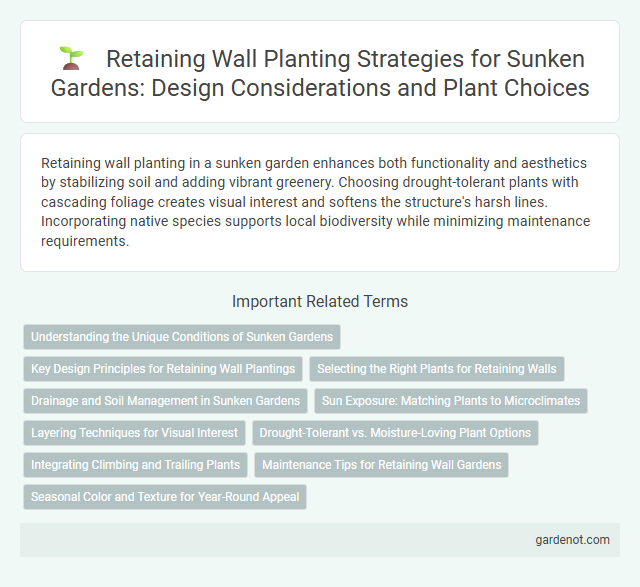Retaining wall planting in a sunken garden enhances both functionality and aesthetics by stabilizing soil and adding vibrant greenery. Choosing drought-tolerant plants with cascading foliage creates visual interest and softens the structure's harsh lines. Incorporating native species supports local biodiversity while minimizing maintenance requirements.
Understanding the Unique Conditions of Sunken Gardens
Retaining wall planting in sunken gardens requires careful selection of plants that thrive in the unique microclimate characterized by lower light levels, higher moisture retention, and temperature variations. Species such as ferns, hostas, and ivy exhibit strong adaptability to the shaded, cool, and often damp conditions found along retaining walls. Understanding soil drainage and root stability is essential to prevent erosion and ensure long-term plant health in these confined, vertical spaces.
Key Design Principles for Retaining Wall Plantings
Effective retaining wall planting requires selecting plants with strong root systems to stabilize soil and prevent erosion in sunken garden environments. Incorporate a mix of trailing plants and upright species to enhance structural integrity while creating visual interest and softening harsh wall lines. Prioritize drought-tolerant, low-maintenance varieties suited to local climate conditions to ensure longevity and sustainability of the planting design.
Selecting the Right Plants for Retaining Walls
Selecting the right plants for retaining walls requires considering root structure, drought tolerance, and soil conditions to ensure stability and longevity. Native ground covers, succulents, and trailing plants like creeping thyme or sedum are ideal for preventing erosion while enhancing aesthetic appeal. Incorporating deep-rooted shrubs such as lavender or ornamental grasses promotes soil retention and creates a vibrant, low-maintenance sunken garden environment.
Drainage and Soil Management in Sunken Gardens
Retaining wall planting in sunken gardens requires effective drainage systems to prevent waterlogging and soil erosion, ensuring plant roots receive optimal aeration and nutrients. Incorporating well-draining soil amendments and layering techniques enhances water infiltration and stabilizes soil structure around retaining walls. Strategic plant selection with deep-root systems further supports soil retention and maintains the integrity of the garden's microenvironment.
Sun Exposure: Matching Plants to Microclimates
Retaining wall planting in sunken gardens requires selecting plants that thrive in the specific microclimates created by varying sun exposure levels. South-facing walls typically receive intense sunlight, favoring drought-tolerant succulents and Mediterranean herbs such as lavender and thyme. North-facing or shaded walls benefit from moisture-loving ferns, hostas, and shade-tolerant groundcovers that maintain vibrant greenery in low-light conditions.
Layering Techniques for Visual Interest
Retaining wall planting utilizes layering techniques by combining ground covers, mid-height shrubs, and taller plants to create depth and visual interest. Selecting drought-tolerant species like creeping thyme, lavender, and ornamental grasses helps maintain structure and texture while reducing maintenance needs. Strategic layering enhances soil retention and integrates the wall seamlessly into the garden's overall landscape design.
Drought-Tolerant vs. Moisture-Loving Plant Options
Retaining wall planting in sunken gardens benefits from selecting drought-tolerant plants such as sedum, lavender, and succulents, which thrive in well-drained, low-moisture environments and reduce water consumption. Conversely, moisture-loving plants like ferns, hostas, and astilbes prefer consistently moist soil and partial shade, ideal for retaining walls near water sources or shaded areas. Balancing these plant types based on microclimates and irrigation availability enhances soil stability, prevents erosion, and maintains vibrant greenery year-round.
Integrating Climbing and Trailing Plants
Integrating climbing and trailing plants into retaining wall planting enhances structural stability while maximizing vertical green space in a sunken garden. Species such as ivy (Hedera helix), creeping fig (Ficus pumila), and star jasmine (Trachelospermum jasminoides) provide dense coverage, reduce soil erosion, and add visual interest with cascading foliage. Proper selection and maintenance of these plants promote a harmonious blend of natural texture and architectural form.
Maintenance Tips for Retaining Wall Gardens
Retaining wall planting demands consistent maintenance to prevent soil erosion and sustain plant health. Regularly inspect walls for cracks and reinforce drainage systems to avoid water damage that could compromise structural integrity. Prune plants to control root growth and select drought-resistant species to minimize watering needs, ensuring long-lasting garden stability and aesthetic appeal.
Seasonal Color and Texture for Year-Round Appeal
Retaining wall planting in a sunken garden enhances seasonal color and texture by incorporating a diverse mix of perennials, evergreens, and flowering shrubs that thrive in varying light conditions. Strategic layering of plants such as ornamental grasses, spring bulbs, and autumnal foliage ensures visual interest throughout the year. Selecting species like hellebores, sedums, and boxwood provides a dynamic combination of vibrant hues and contrasting textures, maintaining consistent appeal across seasons.
Retaining wall planting Infographic

 gardenot.com
gardenot.com